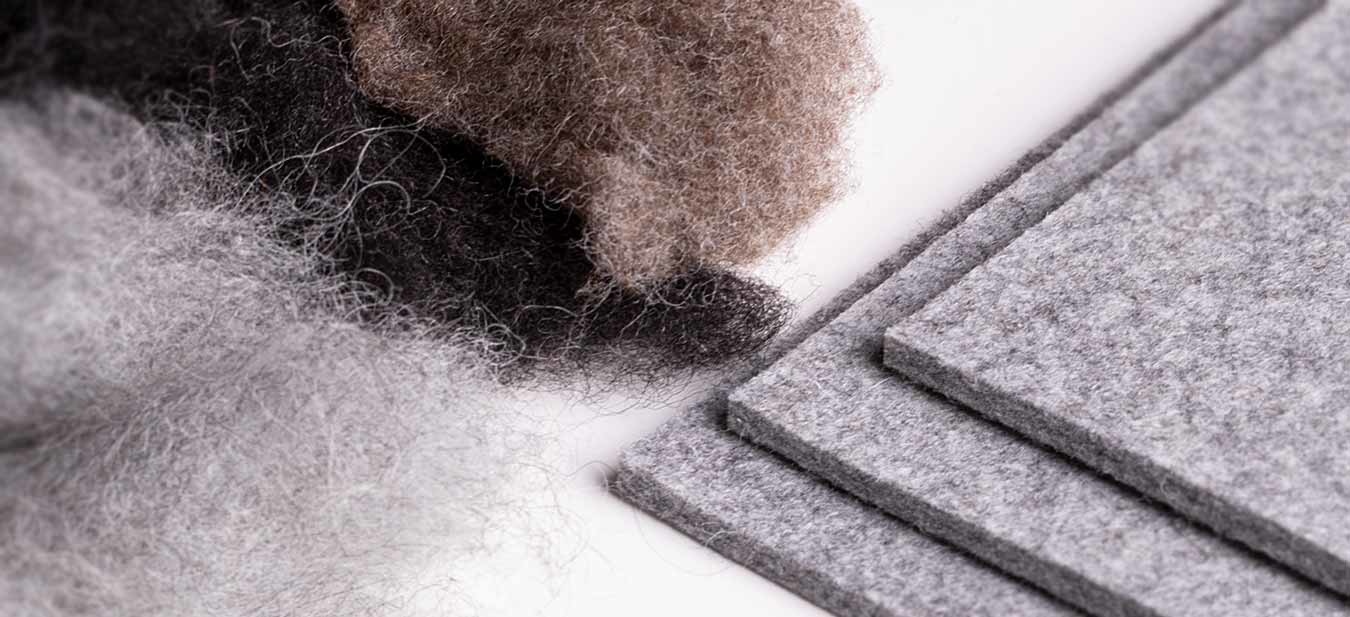
Wool felt properties & info
Wool felt is an important material for interior design and the manufacture of accessories. How is felt made and what makes it so valuable for us?
What actually is wool felt?
Wool felt belongs to the "non-woven" textiles and is made of sheep's wool or virgin wool. It is probably one of the oldest fabrics in human history. The wool can be felted, strengthened and compressed by moisture, heat and friction. This creates an even, flat cloth without a weave structure, the wool felt.

Why felts the wool?
The wool fibers have scaly plates (cuticle scales) on the surface, which act like barbs. They stand up when exposed to moisture and heat. If friction is applied to the fibers, they are joined together and hook into each other.
How is felt made?
First, the raw wool is cleaned and carded (prepared into fleece). Then, by mechanical fulling and hammering in combination with warm water, the fibers of the wool are tightly bound together, intertwined in a disorderly manner and interlocked. The process can be accelerated and strengthened by soapy water. This process can be done industrially on a large scale or by hand for artistic purposes. Depending on the type of wool and the duration and strength of the processing, the felt can go from fluffy soft to board hard. In the process, the felt shrinks: the surface area decreases up to 50%.
How does the felt get its color?
There are 2 different methods to do this:
- The raw felt is made in wool white and then dyed in a coloring bath.
- The color of the felt is created by the wool blend of different, natural wool colors.

Why is wool felt water and dirt repellent?
Due to the lanolin (wool wax or also called wool grease) contained in the felt, water drops first bead up on the surface before they can soak in. This means that they can simply be tapped or dabbed off. Dirt also has a hard time penetrating the fibers and contaminating the felt because of the natural grease layer. This can be thought of as a lotus effect.

Why is felt flame retardant?
The natural fiber wool is very heat resistant. Even at high heat it does not burn, but chars from about 320°C. Due to the density of the felt, oxygen hardly reaches the wool, which additionally inhibits combustion. To really do no harm to the products, you can expose the wool felt to temperatures up to about 220°C.

Why wool felt has a sound-absorbing effect?
The fibers of wool felt dampen noise and swallow sounds: as soon as the sound waves hit the felt, they are not reflected, as by a hard surface. The soft surface of the felt with its irregular fibers and air pockets absorbs the sound. Thus, by using wool felt and wool felt products, you can provide a little more peace and silence in your rooms.

How does the thermal insulation work with felt?
Actually, in the case of felt, it is not the wool at all that is responsible for the heat-insulating properties, but the air trapped in the felt, which is a poor conductor and prevents heat exchange. The wool fibers therefore lock the air in, so that it can circulate poorly within the felt. In this case, the wool serves only as a "natural carrier" of the air. That is why the felt is so comfortable in both heat and cold.

Why is the wool felt moisture-regulating and skin-friendly?
Wool felt is permeable to water vapor, and can transport moisture on the wool fiber. It can absorb up to 50% of its weight in water vapor, store it and then gradually release it back into the environment. At the same time it does not loose its insulating properties. Felt is soft, pleasant to the touch and, being a natural material, does not cause irritation to the skin.

Can wool purify air and break down pollutants?
In many of our living spaces are used building materials that release formaldehyde into the room air. In the scientific work of Stefan Thomé from 2006, it was proven that wool can bind some pollutants: The felt contains the wool protein keratin, which, together with the substances lysine, tyrosine and tryptophan, absorbs pollutants from the indoor air. Thus, wool felt can contribute to a healthier and cleaner indoor air.

Is wool felt biodegradable?
Wool is a natural, renewable raw material. The felt or wool can be broken down again into its elementary components by microorganisms. Minerals and nitrogen are released in the process, similar to horn chips. That is why wool is also used as a fertilizer. It is biodegradable or compostable and thus returns to the natural cycle.

